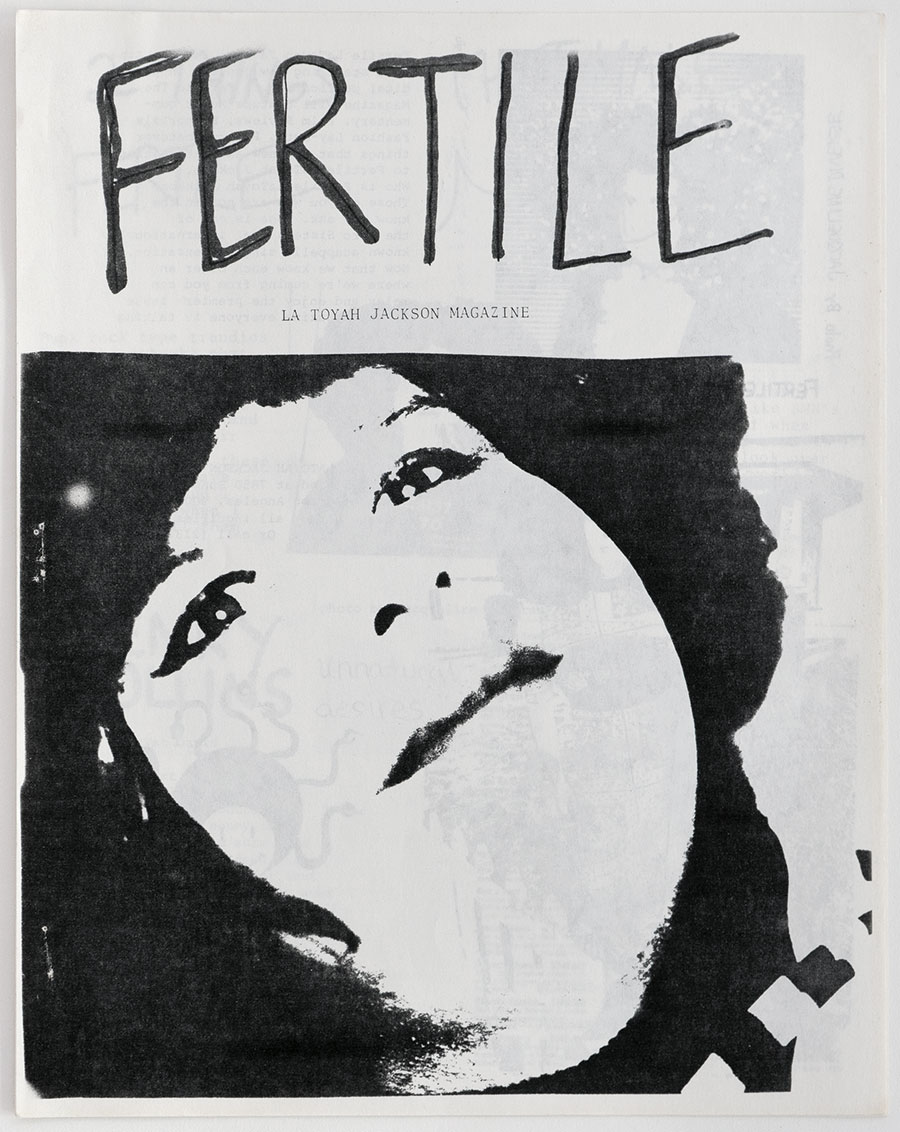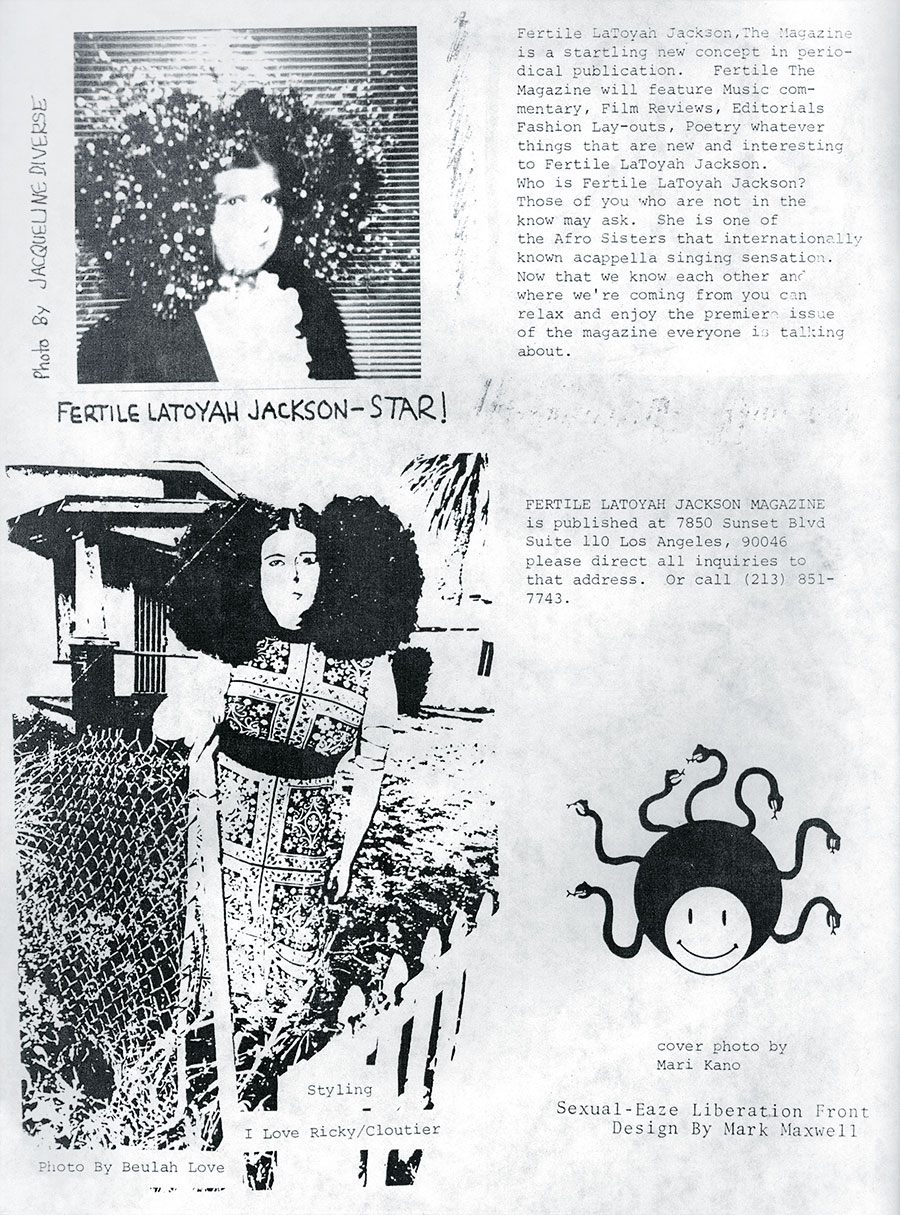Vaginal Davis Loves Big Feet
On the occasion of her exhibition at the Art Institute of Chicago, the artist speaks to Jessica Loudis about moving to Berlin and ‘shrimping’ rituals
On the occasion of her exhibition at the Art Institute of Chicago, the artist speaks to Jessica Loudis about moving to Berlin and ‘shrimping’ rituals

Over the past several decades, performance artist Vaginal Davis (her name is a nod to political activist Angela Davis) has been an iconic figure in the drag, queercore, DIY and punk scenes – first in her native Los Angeles and, subsequently, in Berlin, where she’s been living for the past 15 years. Born intersex, Davis applies her singular sensibility – a mixture of punk, camp, amateur pornography and mid-century Hollywood references – to her work as a curator, writer, performer and visual artist, defining a genre that queer theorist José Esteban Muñoz called ‘terrorist drag’. I met Davis at a cafe in Kreuzberg, several days before her exhibition, ‘The White to Be Angry’, opened at the Art Institute of Chicago. Between far-out stories about celebrity encounters and imaginative sexual acts, Davis reflected on her early years in Los Angeles and the various turns her work has taken over the decades.
Jessica Loudis What made you decide to move to Berlin?
Vaginal Davis I was born and raised in Los Angeles. The last apartment building I lived in there was a gorgeous early version of 1920s streamline moderne, so it looked like a ship. Windows everywhere, nice cross-ventilation. I had a terrace and, on a clear day, I could see Santa Catalina Island and the Hollywood sign. The woman who owned the apartment only rented it to artists; I was there for 20 years or so and she never raised the rent. But, then, her husband sadly developed Alzheimer’s, so she sold the place. I had been paying the same rent for so long that I didn’t realize how high they had gotten in LA!
In 2001, I had a residency here in Berlin. That’s when the CHEAP collective was formed, with our fearless leader Susanne Sachße, film historian Marcuse Siegelstein and his then-boyfriend, translator to the academic stars, Daniel Hendrickson. I’d been in Berlin for six months when Susanne said: ‘Why don’t you move here?’ We were doing the very first CHEAP project, called ‘CHEAP Jewelry’ (2001), which was a salute to the underground filmmaker Jack Smith and the singer Carmen Miranda. Between then and when I did move, in 2005, I went back and forth a lot doing projects with the collective. I never would have imagined myself living in a foreign country. But I just said to myself: ‘What have I got to lose?

JL Have your impressions of the US changed since you’ve been in Berlin?
VD Oh my god, yes! That’s why I could never live in the US again. I don’t even like going back – you feel the ickiness the minute you land. And all those years of not having health insurance. Now I have künstler [artist’s] health insurance, which pays for my acupuncture, my massages and my therapy, which, of course, I need because I’m completely crazy. When you’re caught in between the male and the female, there’s so much within you. And having grown up always being prodded and poked at by doctors ... I have a lot of tissues.
When I was younger and straight guys would go after me, the relationship would always come to an impasse when they felt weirded out. And gay guys aren’t an option because I’m too much of a woman. So, I’ve always been sort of alone. But, as I’m getting older, I’m realizing that I dodged a bullet by not having relationships. I’m still alive because I didn’t have sex during the AIDS epidemic. I was very sexually frustrated, but I channelled all that frustration into my art.
JL And now your exhibition is about to open at the Art Institute of Chicago.
VD I’ve had a great many successes in Chicago. The White to Be Angry, the album from which the show gets its title, was recorded there in 1999 at Steve Albini’s studio, and the first queer zine festival, SPEW: The Homographic Convergence, was held at Randolph Street Gallery in 1991. That was the first time queer zinesters from all over the world got to meet each other because, back in those days, we corresponded via letter. G.B. Jones and I would write 25-page letters to each other so, by the time we actually met, we knew each other well.
JL Which zine were you working on at that time?
VD Fertile La Toyah Jackson Magazine. Its supplement was Shrimp: The Magazine for Licking and Sucking Bigger and Better Feet. I’ve always been into men with giant feet. My shrimping rituals involved offering a young guy to the goddesses. He’d be barefoot, covered in fresh-cut flowers, and I’d put maraschino cherries between his toes and cover them with Aunt Jemima light syrup and whipped cream. Then I’d sing a shrimp song. At the very end of the song, I would lovingly lick everything off his feet. You never really heard about shrimping until my zine did it, and now it’s everywhere – it’s caught on with the mainstream porn world.
That reminds me of the time I did a show in Liverpool for the Homotopia Festival. The curators brought me out and I said to them, jokingly: ‘Oh, I hope you’ve gotten some hot rent boys to come to my hotel room and take care of my sexual needs, because that’s part of my rider.’ And they got them! They hired this cute redhead and this cute blonde, who were both in their early 20s: they were so muscular, so adorable. Of course, with their perfect bodies, I certainly was not getting naked in front of them. So, I just basically art-directed them to do things with each other. It was woooonderful! They were hookers with hearts of gold. I had them for the whole night. At the end, they left their seminal fluids all over my face. Helen Gurley Brown, the former editor-in-chief of Cosmopolitan, was completely right: semen is the best facial mask you could ever get. Then we all had breakfast at the hotel together!

JL Wow! I hope you got a recurring invitation. Speaking of bedrooms, is anything interesting on your nightstand at the moment?
VD I’m reading this book by H.E. Bates called Love for Lydia (1952). It’s set in the 1920s, which is my favourite period, and Lydia is a spoiled heiress who makes all the men in her town fall in love with her. It’s a great book. I’m trying not to read it too fast because I want to savour every little bit of it. I’m also reading America’s Mistress (2013), John L. Williams’s biography of Eartha Kitt. There’s so much I didn’t know – like the fact that Kitt and Orson Welles were lovers! It’s also making me remember her disco phase in the late 1970s and early ’80s, which was amazing. I once saw Kitt sing at the Cinegrill at the Hollywood Roosevelt.
But that’s one thing about growing up in Los Angeles; you see celebrities all the time. I remember once, back in the 1970s, I was walking down Sunset Boulevard and I saw this commotion – it was the opening of a Famous Amos Cookies store. I went in without realizing that it was a celebrity-studded event.
JL At a cookie store?
VD At a cookie store during the daytime! It was around two o’clock in the afternoon, and I think I was 14. The first people I saw were Jodie Foster and her mother, who I guess was also her manager. Jodie made a beeline towards me and started hitting on me! She was a couple of years younger than me, maybe 12, and was really butch, and I’m really femme. At first, I was like: am I misreading the signals here? But she was totally gung-ho. And her mother was not having it. Oh, and Faye Dunaway was there! She was married at the time to Peter Wolf of the J. Geils Band, so he was there, too. And Andy Warhol was there with his backwards wig! That’s how bizarre Los Angeles was in the 1970s. We all had milk and cookies.
This article first appeared in frieze issue 210 with the headline ‘Shrimp Cocktail’.
























